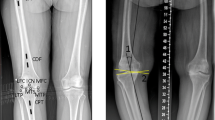Abstract
Background
A mismatch between the prosthesis size and bone may result in a number of complications. Keeping this in view, it is essential to analyze the morphological differences of the knee observed across various ethnic groups to improve the performance of total knee arthroplasty (TKA). The current study was aimed at studying the computed tomography (CT) profile of distal femur in Indian population and evaluates it morphologically.
Materials and Methods
This descriptive study was conducted on 62 patients presenting to the Department of Orthopedics in a tertiary care center in rural north-west India for features suggestive of osteoarthritis and trauma of knee from September 17, 2015 to September 16, 2016. Helical CT of both knees was done, and the data were analyzed using Statistical Package for Social Sciences Version 17.0 statistical significance was assessed with the help of t-test and the value of P < 0.05 was considered to be statistically significant.
Results
The mean mediolateral (ML) value in male patients was 72.74 ± 4.45 while the mean ML value in female patients was lower (63.59 ± 2.61). The mean anteroposterior (AP) value in male patients was significantly (statistically) higher (49.62 ± 3.86) in comparison to mean AP value in female patients (45.11 ± 4.4). The mean anterior lateral condylar height (ALCH) value in male patients was higher (17.53 ± 2.72) in comparison to mean ALCH value in female patients (14.63 ± 3.42).
Conclusions
The current study highlights the need to develop components and implants for use in TKA and fractures of distal femur keeping the age- and sex-specific anatomical features of people of different ethnic origins in view.
Similar content being viewed by others
References
Jain JP. Knee prosthesis sizes in Indian patients undergoing total knee replacement. Int Surg J 2015;2:348–51.
Uehara K, Kadoya Y, Kobayashi A, Ohashi H, Yamano Y. Anthropometry of the proximal tibia to design a total knee prosthesis for the Japanese population. J Arthroplasty 2002;17:1028–32.
Hussain F, Abdul Kadir MR, Zulkifly AH, Sa’at A, Aziz AA, Hossain G, et al. Anthropometric measurements of the human distal femur: A study of the adult Malay population. Biomed Res Int 2013;2013:175056.
Awasthi B, Raina SK, Chauhan N, Sehgal M, Sharma V, Thakur L. Anthropometric characterisation of elbow angles and lines among Indian children. Adv Hum Biol 2017;7:71–4.
Schiphof D, Boers M, Bierma-Zeinstra SM. Differences in descriptions of Kellgren and Lawrence grades of knee osteoarthritis. Ann Rheum Dis 2008;67:1034–6.
Roser M. Human Height. Available from: https://www.ourworldindata.org/human-height. [Last accessed on 2017 Jul 14].
Yue B, Varadarajan KM, Ai S, Tang T, Rubash HE, Li G, et al. Differences of knee anthropometry between Chinese and white men and women. J Arthroplasty 2011;26:124–30.
Hitt K, Shurman JR 2nd, Greene K, McCarthy J, Moskal J, Hoeman T, et al. Anthropometric measurements of the human knee: Correlation to the sizing of current knee arthroplasty systems. J Bone Joint Surg Am 2003;85-A Suppl 4:115–22.
Clarke HD, Hentz JG. Restoration of femoral anatomy in TKA with unisex and gender-specific components. Clin Orthop Relat Res 2008;466:2711–6.
Lonner JH, Jasko JG, Thomas BS. Anthropomorphic differences between the distal femora of men and women. Clin Orthop Relat Res 2008;466:2724–9.
Chin PL, Tey TT, Ibrahim MY, Chia SL, Yeo SJ, Lo NN, et al. Intraoperative morphometric study of gender differences in Asian femurs. J Arthroplasty 2011;26:984–8.
Ho WP, Cheng CK, Liau JJ. Morphometric measurements of resected surface of femurs in Chinese knees: Correlation to the sizing of current femoral implants. Knee 2006;13:12–4.
Vaidya SV, Ranawat CS, Aroojis A, Laud NS. Anthropometric measurements to design total knee prostheses for the Indian population. J Arthroplasty 2000;15:79–85.
Cheng FB, Ji XF, Lai Y, Feng JC, Zheng WX, Sun YF, et al. Three dimensional morphometry of the knee to design the total knee arthroplasty for Chinese population. Knee 2009;16:341–7.
Ha CW, Na SE. The correctness of fit of current total knee prostheses compared with intra-operative anthropometric measurements in Korean knees. J Bone Joint Surg Br 2012;94:638–41.
Deaton A. Height, health, and inequality: The distribution of adult heights in India. Am Econ Rev 2008;98:468–74.
Author information
Authors and Affiliations
Corresponding author
Rights and permissions
About this article
Cite this article
Awasthi, B., Raina, S.K., Negi, V. et al. Morphometric Study of Lower End Femur by Using Helical Computed Tomography. JOIO 53, 304–308 (2019). https://doi.org/10.4103/ortho.IJOrtho_136_17
Published:
Issue Date:
DOI: https://doi.org/10.4103/ortho.IJOrtho_136_17




